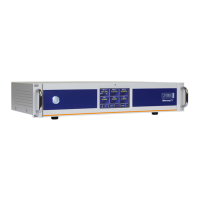MercuryiTC
©2014 Oxford Instruments Omicron NanoScience. All rights reserved.
Page 151
14.3.2 Manual control of the gas flow
When the gas control is set to MANUAL mode, the valve is driven to a fixed position to provide
constant cooling power. Temperature control is then provided by controlling the heater output.
14.3.3 Automatic control of the gas flow
When the gas control is set to AUTOmatic mode, the position of the needle valve is
automatically controlled to provide variable cooling power. In conjunction with the heater, this
enables accurate temperature control at cryogenic temperatures.
The position of the needle valve is controlled by a control function that operates relative to the
present valve position rather than to an absolute position.
The output of the control function is related to the valve position by a Valve Gearing parameter.
This parameter defines how many steps of the stepper motor exist between the valve fully-open
and the valve fully-closed positions. Changing the Valve Gearing parameter allows the iTC to
match a variety of stepper-motor and needle-valve combinations.
The control function is driven by two error signals:
• Temperature Error Sensitivity (TES)
the difference between the temperature measured by the sensor and the temperature set-
point.
• Target Voltage Error Sensitivity (TVES)
the difference between the actual heater voltage delivered by the heater control loop and the
target heater voltage.
Both error signals are scaled by the error sensitivities (see section 4.9.1), and both are also
compensated for non-linearity of the valve (the error sensitivity decreases with increasing
temperature and decreasing flows).
The sensitivity to a temperature error is such that the valve responds to large temperature
errors, but is relatively unaffected by small errors. This means that fine control of temperature
near the setpoint is dominated by the heater.
When the system is in control at the setpoint, the temperature error is, by definition, zero.
Control of the valve position is thus dominated by the heater voltage error, and the cooling is
adjusted until the heater voltage reaches its target value. The system is at equilibrium when

